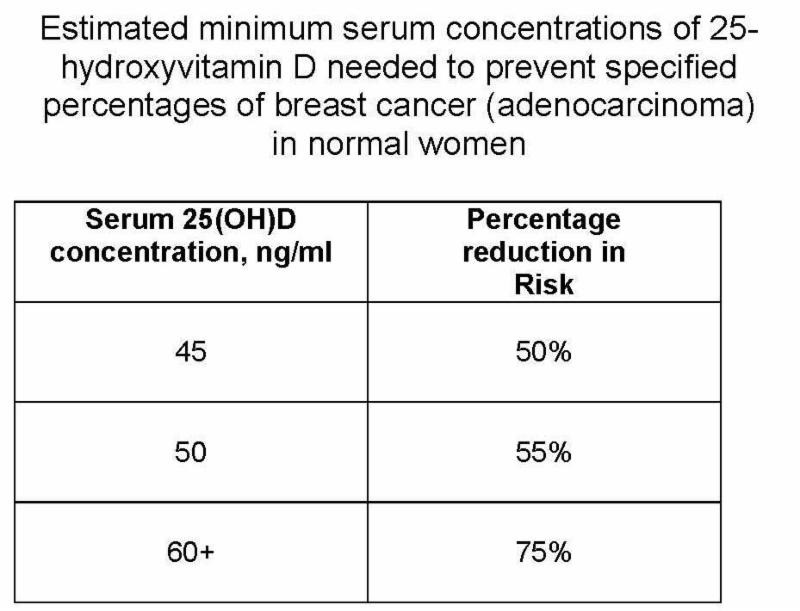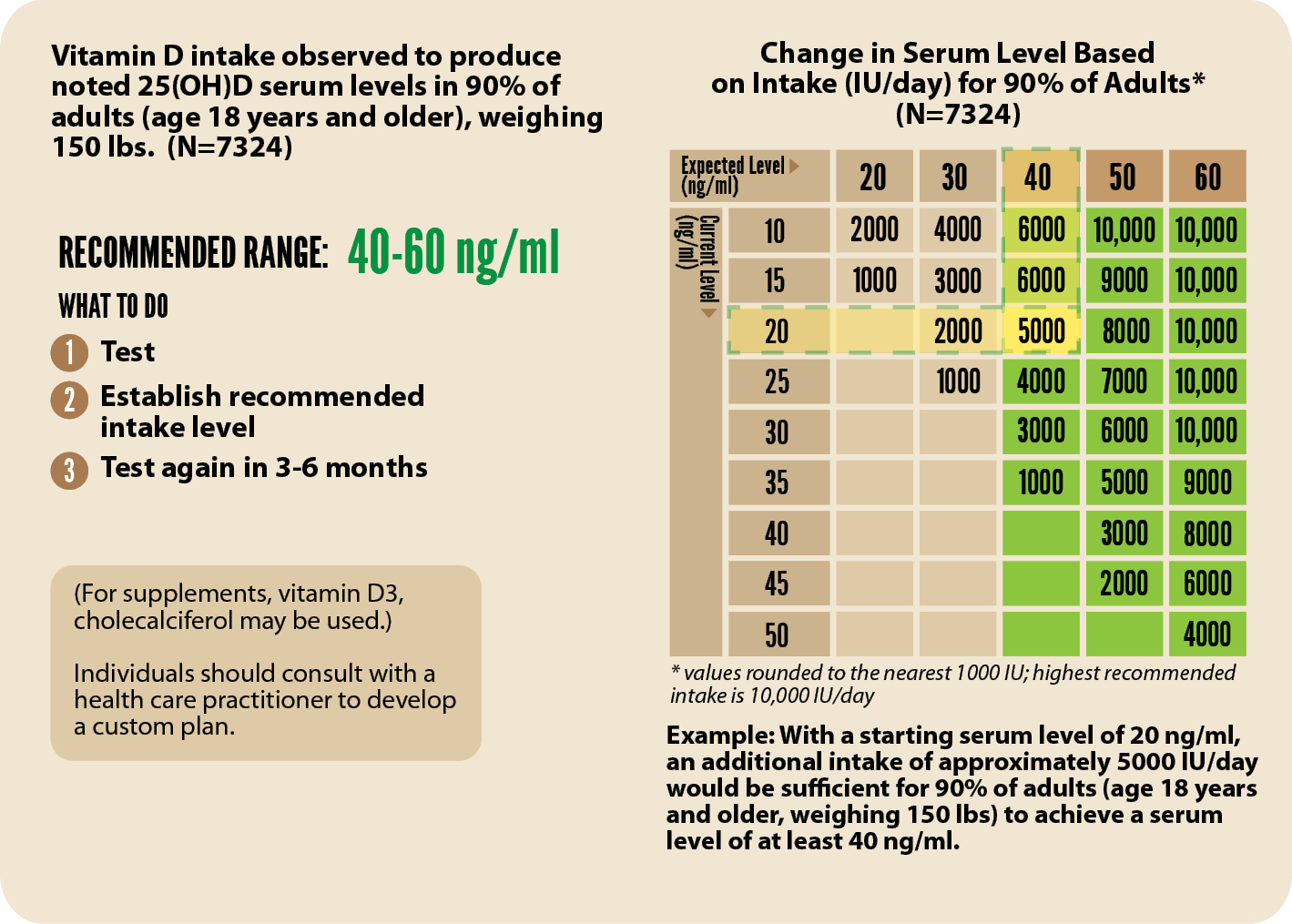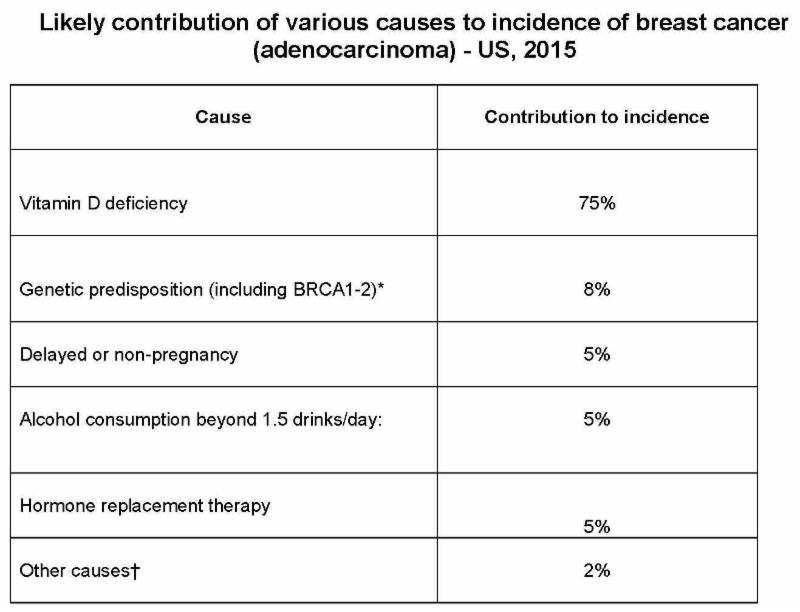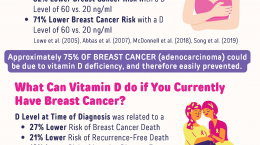Published on April 18, 2019
Written by Cedric F. Garland, Dr. P.H. F.A.C.E.
University of California at San Diego Medical Center
Note: References, e.g. (1), are located below.
Although it afflicts 232,000 American women each year and kills 40,000 (1), breast cancer is among the 2nd or 3rd most readily preventable cancers (2-4).
How could breast cancer be prevented?
One way to reduce risk of breast cancer is to avoid excessive consumption of alcohol. For women the safe limit is no more than 1.5 4-ounce glasses of wine, 12 ounce glasses of beer or cocktails per 24 hours (5).
Vitamin D plays an important role. Approximately 75% of breast cancer (adenocarcinoma) could be due to vitamin D deficiency (Table 1).
There are also other known causes, the most influential of which are BRCA and a few rare alleles of other genes (6). The table below lists these and other common causes of breast cancer and their likely contribution to its incidence.
Table 1
What is a good target vitamin D serum level for breast cancer prevention?
A paper published by GrassrootsHealth in June 2018 combined the data from participants in two randomized controlled trials (RCT) and our Breast Cancer Prevention Project participants. The analysis uncovered an 82% lower rate of breast cancer for participants with vitamin D levels of at least 60 ng/ml, compared to those with levels less than 20 ng/ml (7).
While adequate vitamin D status could prevent 75% of breast cancer (Table 1 above) or even 82% of breast cancer as found in the GrassrootsHealth publication, it also could make occasional “breakthrough cases” that may occur despite vitamin D adequacy much less life-threatening and easier to treat (8). Patients with serum 25-hydroxyvitamin D concentrations of 40-50 ng/ml may likely have a milder form of the disease with substantially better chance of long-term survival. The minimum serum 25(OH)D concentrations needed to prevent breast cancer are summarized in Table 2 below.

Table 2
How much vitamin D is needed to reach my target level?
Based on a plot of 25(OH)D values as a function of reported vitamin D intake amounts for 7,324 D*action participants, a calculation was produced to estimate the additional daily vitamin D intake needed for 90% of adults to reach a chosen target 25(OH)D serum level (age 18 years and older, weighing an average of 150 lbs). The chart below can be used as a tool to calculate how much additional supplemental vitamin D is needed to get 90% of individuals from an initial vitamin D serum level to a desired vitamin D serum level.

For the most accurate calculation, use the GrassrootsHealth vitamin D calculator.
What else could be considered for prevention?
Still other gains may be achieved by minimizing x-ray exposures that may penetrate the breast epithelium directly or due to scattering from bones or teeth. One study indicated that mammographic screening should be obtained no more than once every 2 years. Women who are less than 50 years old also should consider deferring their first mammogram to age 50 unless there are certain risk factors present. This decision should be discussed thoroughly with the individual’s physician.
For women with BRCA 1-2 or CDH1 mutations, the only known method of prevention, sadly, is prophylactic mastectomy. This is the approach used by actress Angelina Jolie who was BRCA positive and had several close relatives with breast cancer. Research is badly needed to determine whether vitamin D might reduce the need for prophylactic mastectomy in women with these BCRA mutations.
Summary
Breast cancer is one of the easiest of all cancers to prevent. But it requires devotion to consuming an adequate amount of vitamin D3 and testing your serum 25(OH)D concentration faithfully, especially in February or March of each year. Discuss your plan with your doctor, and bring them on board concerning your quest to minimize risk of breast cancer. Any up-to-date well-informed doctor will admire and support what you are doing, and can help you consume adequate vitamin D3 while avoiding needless risk.
Vitamin D matters!! To prevent AND to reduce probability of recurrence of cancer.
What is your vitamin D level? Make sure you know yours is it at a level that could help prevent or reduce recurrence of cancer. Find out today! Log on to the shop (click the link below) to get your tests and see for yourself if your supplementation routine has helped you reach your target vitamin D level.
Make sure you track your results before and after, about every 6 months!
Click Here to Access the Shop Page
How can I track my Vitamin D levels?
To help you track your nutrient levels, GrassrootsHealth has created an online tracking system called myData-myAnswers. You can also track your supplemental and dietary nutrient intake to see how they impact your nutrient levels. Check it out today!
References
(1) American Cancer Society. Cancer facts and figures 2015. Atlanta: ACS, 2015, p. 4.
(2) Garland CF, Garland FC, Gorham ED, et al. The role of vitamin D in cancer prevention. American Journal of Public Health 2006; 96(2): 252-261.
(3) Garland CF, Gorham ED, Mohr SB, et al. Vitamin D for cancer prevention: global perspective. Annals of Epidemiology 2009;19(7):468-83.
(4) Lowe LC, Guy M, Mansi J et al. Plasma 25-hydroxyvitamin D concentrations, vitamin D receptor genotype and breast cancer risk in a UK Caucasian population. European Journal of Cancer 2005;41:1164-1169.
(5) Chen WY, Rosner B, Hankinson SE et al, Moderate Alcohol Consumption During Adult Life, Drinking patterns and breast cancer JAMA 2011; 306 (17): 1884-1890.
(6) Karami F, Mehdipour P. A Comprehensive Focus on Global Spectrum of BRCA1 and BRCA2 Mutations in Breast Cancer. Biomed Res Int. 2013; 2013: 928562.
(7) McDonnell SM, Baggerly CA, French CB, et al. Breast cancer risk markedly lower with serum 25-hydroxyvitamin D concentrations ≥60 vs <20 ng/ml (150 vs 50 nmol/L): Pooled analysis of two randomized trials and a prospective cohort. PLoS ONE 2018; 13(6): e0199265.
(8) Mohr S, Gorham ED, Kim J, et al. Meta-analysis of vitamin D sufficiency for improving survival of patients with breast cancer.Anticancer Research 2014; 34: 1163-1166.









